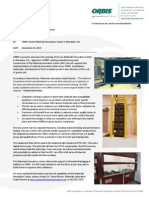Emergence of Modern Architecture
Emergence of Modern Architecture
Uploaded by
Aziz KhanCopyright:
Available Formats
Emergence of Modern Architecture
Emergence of Modern Architecture
Uploaded by
Aziz KhanOriginal Description:
Original Title
Copyright
Available Formats
Share this document
Did you find this document useful?
Is this content inappropriate?
Copyright:
Available Formats
Emergence of Modern Architecture
Emergence of Modern Architecture
Uploaded by
Aziz KhanCopyright:
Available Formats
EMERGENCE OF MODERN ARCHITECTURE
BY CHAITANYA AGRAWAL. BAKULESH BHOGLE. RIDDHI PARMAR.
Modern architecture is a term applied to an period in
architectural history during the 20th century, with its exact definition and scope varying widely. Modern architecture began at the turn of the 20th century with advancement and the modernization of efforts to reconcile the principles underlying architectural design with rapid technological society. When compared to that which preceded it, modernism in architecture is broadly characterized by simplification of form and subtraction of ornament from the structure and theme of the building.
Common themes of modern architecture include: "Form follows function", meaning that the result of design
should derive directly from its purpose. Simplicity and clarity of forms and elimination of "unnecessary detail" Visual expression of structure (as opposed to the hiding of structural elements) The related concept of "Truth to materials", meaning that the true nature or natural appearance of a material ought to be seen rather than concealed or altered to represent something else. Use of industrially-produced materials; adoption of the machine aesthetic.
There are multiple lenses through which the evolution
of modern architecture may be viewed. Some historians see it as a social matter, closely tied to the project of Modernity and thus the Enlightenment. Modern architecture developed, in their opinion, as a result of social and political revolutions. Others see Modern architecture as primarily driven by technological and engineering developments. Still other historians regard Modernism as a matter of taste, the lavish stylistic excesses of architecture.
With the Industrial Revolution, the availability of
newly-available building materials such as iron, steel, and sheet glass drove the invention of new building techniques. It was not until the early 1830s that Eaton Hodgkinson introduced the section beam, leading to widespread use of iron construction. A further development was that of the steel-framed skyscraper in Chicago around 1890 by William Le Baron Jenney and Louis Sullivan.
The Congrs Internationaux d'Architecture Moderne
(CIAM) would be a force in the shaping Modernist urban planning, and consequently the design of cities and the structures within, from 1928 to 1959. Following its principles, in the late 1950s the entirelynew city of Braslia was built as a new capital for Brazil, designed by Lucio Costa, with prominent works for it designed by Oscar Niemeyer. In the Eastern Bloc, mass housing would take the form of prefabricated panel buildings, such as the Plattenbau of East Germany, Khrushchyovka of Russia and the Panelk of Czechoslovakia.
As the International Style took hold, others architects
reacted to or strayed from its the purely functionalist forms, while at the same time retaining highly modernist characteristics. Mid-century modernism, or organic modernism, was very popular, due to its democratic and playful nature. Expressionist exploration of form was revived, such as in the Sydney Opera House in Australia by Jrn Utzon.
Tube architecture : "a three dimensional space structure composed of three, four, or possibly more frames, braced frames, or shear walls, joined at or near their edges to form a vertical tube-like structural system capable of resisting lateral forces in any direction by cantilevering from the foundation. The first building to apply the tube-frame construction was the DeWitt-Chestnut Apartment Building which Khan designed and was completed in Chicago by 1963.
Chicago, Illinois. IBM Plaza (right), by Ludwig Mies van der Rohe
The Salk Institute complex in La Jolla, California, by architect Louis Kahn.
The Bauhaus building at Dessau, designed by Walter Gropius
National Congress of Brazil, by Oscar Niemeyer, in the modernist-designed city of Brasilia
Lincoln Center for the Performing Arts, New York City, illustrating an example of "New Formalism"
The Sony Building (formerly AT&T building) in New York City, 1984, by Philip Johnson
In 2007, the Sydney Opera House by Jrn Utzon was listed as a World Heritage Site.
Modern architecture met with some criticism,
which began in the 1960s on the grounds that it seemed universal, elitist, and lacked meaning. The loss of traditionalist structures to make way for new modernist construction, especially via the Urban Renewal movement, led to further criticism.
Architects explored Postmodern architecture which
offered a blend of some pre-modern elements, and deliberately sought to move away from rectilinear designs, towards more eclectic styles. High Postmodern aesthetics lacked traction and by the mid-1990s, a new surge of modern architecture once again established international pre-eminence. Although modern and postmodern design compete with a revival of traditional architectural design in commercial and institutional architecture; residential design continues to be dominated by a traditional aesthetic.
In Ancient Architecture their was use of natural
resources or readily available materials like stone, sand, etc. But as emergence of modern Architecture started the use of new and different types of materials like steel, cement, etc started. As the emergence started the way and techniques of designing also started changing time to time.
You might also like
- Faithful Spy PDFDocument2 pagesFaithful Spy PDFLucioNo ratings yet
- The Beginning of Modern Architecture - Boundless Art HistoryDocument14 pagesThe Beginning of Modern Architecture - Boundless Art HistorySanderNo ratings yet
- Guggenheim PDFDocument11 pagesGuggenheim PDFAll about NBJNo ratings yet
- The New Museum of Contemporary ArtDocument3 pagesThe New Museum of Contemporary Artmackard57No ratings yet
- Architecture HistoryDocument42 pagesArchitecture HistoryTayyabNo ratings yet
- Bauhaus ArchitectureDocument22 pagesBauhaus ArchitecturevijayaratnaNo ratings yet
- Frank Gehry: DeconstructivismDocument24 pagesFrank Gehry: Deconstructivismশান্তনু বৰুৱা100% (1)
- Briggs, A. The Welfare State in Historical PerspectiveDocument40 pagesBriggs, A. The Welfare State in Historical PerspectiveCatia Ferreira100% (1)
- HOA - Early IslamicDocument29 pagesHOA - Early IslamicNeeraj VashistNo ratings yet
- Modern Architectural Thought - DA2: Critic: Schauspielhaus, BerlinDocument3 pagesModern Architectural Thought - DA2: Critic: Schauspielhaus, BerlinKavvyaNo ratings yet
- 09 Functionalism in Modern ArchitectureDocument13 pages09 Functionalism in Modern ArchitectureYukta100% (1)
- Post War Decades-International StyleDocument41 pagesPost War Decades-International StyleGaurika Grover100% (2)
- FunctionalismDocument3 pagesFunctionalismClearyne Banasan100% (1)
- HOA - Unit 02 - Modernism and International StyleDocument30 pagesHOA - Unit 02 - Modernism and International Style1210101075 SAUMYAJIT BISWASNo ratings yet
- Case Study Adaptive ReuseDocument7 pagesCase Study Adaptive Reusesharvani kbNo ratings yet
- International Style and ModernismDocument25 pagesInternational Style and Modernismjames.molinaNo ratings yet
- Week 1 Lecture Introduction To ArchitectureDocument40 pagesWeek 1 Lecture Introduction To ArchitectureTerra DrakeNo ratings yet
- Greek Arch - Ist ModDocument42 pagesGreek Arch - Ist ModSohanNo ratings yet
- Yra - 3rd Class - Building - Archi - ArchitectureDocument169 pagesYra - 3rd Class - Building - Archi - ArchitectureAshru SigdelNo ratings yet
- PostmodernismDocument18 pagesPostmodernismPREETHI M ANo ratings yet
- 1.NOTES - Introduction - Contemporary Architecture in IndiaDocument6 pages1.NOTES - Introduction - Contemporary Architecture in IndiaShifa Talath100% (2)
- HoA3 (6. Pre-Independence Architecture in India)Document9 pagesHoA3 (6. Pre-Independence Architecture in India)052 Deepak NaralaNo ratings yet
- TOA (Charles Rennie Mackintosh)Document15 pagesTOA (Charles Rennie Mackintosh)ANCHAL MISHRA100% (1)
- Floor Plan FeaturesDocument18 pagesFloor Plan FeaturesKing Rey YapNo ratings yet
- Laurie Baker - Design & ThinkingDocument12 pagesLaurie Baker - Design & ThinkingAr AntarikshNo ratings yet
- Post Independence Architecture (Vishal, Anisha)Document17 pagesPost Independence Architecture (Vishal, Anisha)Geetakshri JajoriaNo ratings yet
- History and Theory Studies 2011-2012Document41 pagesHistory and Theory Studies 2011-2012Farid NakhjavaniNo ratings yet
- Philip JohnsonDocument39 pagesPhilip JohnsonNehaKharb100% (3)
- Laurie BakerDocument12 pagesLaurie BakerarchitectbsNo ratings yet
- Maria Christodoulou - ST Basil's CathedralDocument7 pagesMaria Christodoulou - ST Basil's CathedralLikhitaKaranamNo ratings yet
- History of Architecture Featuring Japanese Architecture and Chinese ArchitectureDocument16 pagesHistory of Architecture Featuring Japanese Architecture and Chinese ArchitectureMark Joefill SalgadoNo ratings yet
- Mod 4 Postmodernism 2Document21 pagesMod 4 Postmodernism 2Abdul AzeesNo ratings yet
- Architecture Conservation Lecture 010 Pujari MathDocument9 pagesArchitecture Conservation Lecture 010 Pujari Mathrita khadkaNo ratings yet
- Indicative Location of Utility Elements:: Air Conditioner, Electrical Outlet & SwitchesDocument39 pagesIndicative Location of Utility Elements:: Air Conditioner, Electrical Outlet & SwitchesGlennson BalacanaoNo ratings yet
- Bauhaus PPT 1Document6 pagesBauhaus PPT 1Debashree MishraNo ratings yet
- Modernism 170221162809Document89 pagesModernism 170221162809Rohan MittalNo ratings yet
- Byzantine ArchitectureDocument7 pagesByzantine ArchitectureRahma IsmailNo ratings yet
- 1-2modern Architecture N Characteristics and ExamplesDocument13 pages1-2modern Architecture N Characteristics and Examplessanchit gupta100% (1)
- Post Independence NewDocument13 pagesPost Independence NewAnjali RaoNo ratings yet
- Ludwig Mies Van Der RoheDocument11 pagesLudwig Mies Van Der RoheManthan KirdatNo ratings yet
- Daniel Libeskind: Unit 1 Architecture and MeaningDocument42 pagesDaniel Libeskind: Unit 1 Architecture and MeaningAtshayaNo ratings yet
- Architectural Design I: SyllabusDocument3 pagesArchitectural Design I: SyllabusSrilakshmi PriyaNo ratings yet
- Chinese ArchitectureDocument68 pagesChinese ArchitectureJohn Irvin NorbertoNo ratings yet
- INTD402 Furniture, Fittings, Textile & AcessoriesDocument34 pagesINTD402 Furniture, Fittings, Textile & AcessoriesAmr MohamedNo ratings yet
- Lecture 1 IntroductionDocument56 pagesLecture 1 IntroductionRohit JainNo ratings yet
- Watson Hotel HistoryDocument12 pagesWatson Hotel HistoryKathryn S. MollerNo ratings yet
- History of Architects (Michael Graves)Document18 pagesHistory of Architects (Michael Graves)BhuvanaNo ratings yet
- Design Brief of AcademyDocument6 pagesDesign Brief of AcademyBatch 2018 DEVAROSHAN ANo ratings yet
- Heydar Aliyev Center: Zaha HadidDocument20 pagesHeydar Aliyev Center: Zaha HadidLokeshNo ratings yet
- Medieval Architecture GOTHIC BYZANTINEDocument26 pagesMedieval Architecture GOTHIC BYZANTINEpratham goswamiNo ratings yet
- 20th CENTURY ARCHITECTUREDocument39 pages20th CENTURY ARCHITECTUREJessicaNo ratings yet
- AR 1121/D Visual Techniques 2: "Introduction To Opaque Colors"Document6 pagesAR 1121/D Visual Techniques 2: "Introduction To Opaque Colors"Myla ArcaNo ratings yet
- Principle of Architectural Design: DAAT 1043Document33 pagesPrinciple of Architectural Design: DAAT 1043Fais Ibrahim100% (1)
- Louis SullivanDocument13 pagesLouis SullivanbiancaraferNo ratings yet
- Solomon Museum: Frank Lloyd WrightDocument56 pagesSolomon Museum: Frank Lloyd WrightHurinur Öztürk100% (1)
- Monuments of Odhisha CompressedDocument91 pagesMonuments of Odhisha CompressedSatyam RoutNo ratings yet
- Vernacular ArchitectureDocument14 pagesVernacular Architecturerevathisasikumar5420No ratings yet
- Hoa 3 FlashcardsDocument10 pagesHoa 3 FlashcardsNoemi D. BreñaNo ratings yet
- Lecture 1 - Heritage DocumentationDocument5 pagesLecture 1 - Heritage Documentationtahreem shahNo ratings yet
- Hoa ReviewerDocument11 pagesHoa Revieweranonuevo.chloe14No ratings yet
- The Impact of Industrialisation and Development of Modern ArchitectureDocument5 pagesThe Impact of Industrialisation and Development of Modern ArchitectureAnusha Singh ChauhanNo ratings yet
- The Beginning of Modern ArchitectureDocument11 pagesThe Beginning of Modern ArchitectureChicken NoodlesNo ratings yet
- EbankingDocument2 pagesEbankingAziz KhanNo ratings yet
- Program For Sports ComplexDocument5 pagesProgram For Sports ComplexAziz Khan50% (4)
- Vizcam Business Profile PDFDocument5 pagesVizcam Business Profile PDFAziz KhanNo ratings yet
- Rise in Buddhism and JainismDocument9 pagesRise in Buddhism and JainismAziz KhanNo ratings yet
- Overview Cover PagesDocument1 pageOverview Cover PagesAziz KhanNo ratings yet
- PantheonDocument4 pagesPantheonAziz KhanNo ratings yet
- Acoustics ElectivesDocument17 pagesAcoustics ElectivesAziz KhanNo ratings yet
- Orders of ColumnsDocument6 pagesOrders of ColumnsAziz KhanNo ratings yet
- Paleolithic and NeolithicDocument18 pagesPaleolithic and NeolithicAziz Khan100% (1)
- Mesopotamian CivilizationDocument19 pagesMesopotamian CivilizationAziz Khan100% (2)
- Greek ReportDocument15 pagesGreek ReportAziz KhanNo ratings yet
- Ancient Pakistan & Indus Valley Civilization: Analysis ReportDocument4 pagesAncient Pakistan & Indus Valley Civilization: Analysis ReportAziz KhanNo ratings yet
- Buddhist ArchitectureDocument10 pagesBuddhist ArchitectureAziz KhanNo ratings yet
- An Overview of CivilizationDocument42 pagesAn Overview of CivilizationAziz KhanNo ratings yet
- Dravidian OriginDocument8 pagesDravidian OriginAziz KhanNo ratings yet
- AtriumDocument18 pagesAtriumAziz KhanNo ratings yet
- Ancient Egyptian ArchitectureDocument34 pagesAncient Egyptian ArchitectureAziz KhanNo ratings yet
- Architect Shigeru BanDocument26 pagesArchitect Shigeru BanAziz KhanNo ratings yet
- Making Sense of China - K SubrahmanyamDocument2 pagesMaking Sense of China - K SubrahmanyamBondBestNo ratings yet
- Story - ORBIS Material Innovations Center OpeningDocument1 pageStory - ORBIS Material Innovations Center OpeningklavinioNo ratings yet
- Uni Potsdam DissertationenDocument4 pagesUni Potsdam DissertationenBuyLiteratureReviewPaperUK100% (1)
- Bank Question For DiscussDocument7 pagesBank Question For Discusssaepulloh bin amingNo ratings yet
- GISAREG - GIS For Irigation PDFDocument21 pagesGISAREG - GIS For Irigation PDFArseni MaximNo ratings yet
- Proctor Test and Field Density TestsDocument7 pagesProctor Test and Field Density TestsRamprasad Rakhonde100% (1)
- Week 7 Writing AssignmentDocument4 pagesWeek 7 Writing Assignmentrpoka003No ratings yet
- Module2 WorksheetDocument5 pagesModule2 WorksheetAeyoumir4 FeNo ratings yet
- ACCTG 104 Quiz Answer Review - MidtermsDocument6 pagesACCTG 104 Quiz Answer Review - MidtermsJyNo ratings yet
- ENGL 3850 Syllabus (FA21)Document10 pagesENGL 3850 Syllabus (FA21)Nathaniel RiversNo ratings yet
- BMW E38-E39 Bordcomputer Service Menu EngishDocument7 pagesBMW E38-E39 Bordcomputer Service Menu EngishRafael Calvo SerranoNo ratings yet
- Architecture, Modernity and Modernization - Proposta Louis CohenDocument3 pagesArchitecture, Modernity and Modernization - Proposta Louis CohenC2 FAUPNo ratings yet
- HRM Assignment - 2 - YogenderDocument3 pagesHRM Assignment - 2 - YogenderharryNo ratings yet
- NCP Pregnancy Induced HypertentionPreeclampsiaEclampsiaDocument2 pagesNCP Pregnancy Induced HypertentionPreeclampsiaEclampsiaRabena, Steven AllenNo ratings yet
- Future Business Leaders of America State of Louisiana BylawsDocument7 pagesFuture Business Leaders of America State of Louisiana BylawsTestNo ratings yet
- Determining Types of Workplace Incivility and Their Relationship To Counterproductive Work Behaviors - Towards The Development of HR Interventions (Neri, 2019)Document213 pagesDetermining Types of Workplace Incivility and Their Relationship To Counterproductive Work Behaviors - Towards The Development of HR Interventions (Neri, 2019)Susan Grace NeriNo ratings yet
- Database Design: Database Systems: Design, Implementation, and Management, Seventh Edition, Rob and CoronelDocument42 pagesDatabase Design: Database Systems: Design, Implementation, and Management, Seventh Edition, Rob and CoronelJoshua CareloNo ratings yet
- Extreme ProgrammingDocument4 pagesExtreme ProgrammingpavithraNo ratings yet
- Time Table Jan-May 2011 W.E.F. 13 Jan 2011Document6 pagesTime Table Jan-May 2011 W.E.F. 13 Jan 2011ProgramerrNo ratings yet
- Mission Statements of NikeDocument12 pagesMission Statements of Nikemkam212No ratings yet
- ORGB24 G24 BNT GroupActivity FinalBusinessReport Group3Document10 pagesORGB24 G24 BNT GroupActivity FinalBusinessReport Group3orozcokyriel.caNo ratings yet
- Religion and Its Role in Human LifeDocument16 pagesReligion and Its Role in Human Lifeansar aliNo ratings yet
- Dataeng Lq1 NotesDocument11 pagesDataeng Lq1 NotesChristine TabangNo ratings yet
- Biology Notes: Topic 1CDocument3 pagesBiology Notes: Topic 1Claiba amirNo ratings yet
- Borrowed WordsDocument6 pagesBorrowed WordsLevindoNascimentoNo ratings yet
- 1st Friday, 05.06.22Document98 pages1st Friday, 05.06.22Nov YtubeNo ratings yet
- SSR Part 1 JHBWC 2015 PDFDocument229 pagesSSR Part 1 JHBWC 2015 PDFJoshi AdityaNo ratings yet
- Accomplishment Report Book Week CelebrationDocument4 pagesAccomplishment Report Book Week CelebrationgeonzonloveliaNo ratings yet











































































































